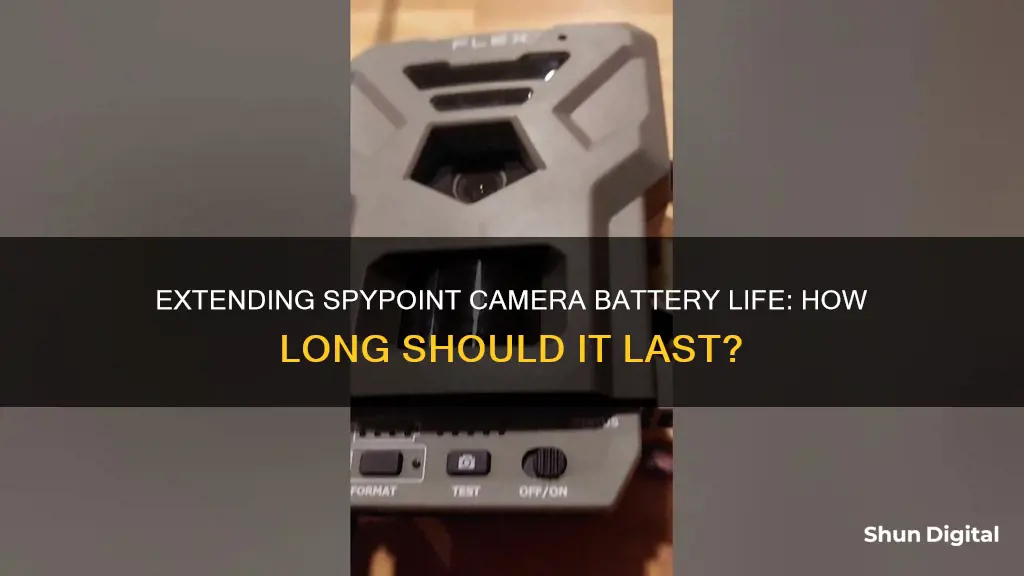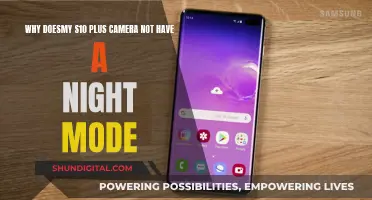
The battery life of a SpyPoint camera depends on several factors, including the type of battery used, the settings, and the environment. SpyPoint cameras typically use AA batteries, with lithium batteries being the best choice due to their longer lifespan, reliability in extreme temperatures, and compactness. The recording mode also affects battery life, with continuous recording consuming more power and resulting in shorter battery life. Other factors include the proportion of day/night images, power source, and type of acquisition (photo/video). Additionally, features such as live streaming, a built-in viewing screen, night vision, and audio recording will also impact the battery life. To extend the battery life of your SpyPoint camera, consider using rechargeable batteries or investing in a rechargeable lithium battery pack specifically designed for SpyPoint cameras, such as the LIT-10 or LIT-22.
What You'll Learn

Continuous Recording vs Motion-Activated Recording
The battery life of a SpyPoint camera varies depending on several factors, including transmission frequency, the proportion of day/night images, power source, and type of acquisition (photo/video).
To maximize battery life, it is essential to consider the camera's settings and features. For instance, the photo burst, photo delay, and photo quality settings can significantly impact battery life. A higher photo count, such as in photo burst mode, will consume more power, especially if nighttime detections require a flash. Similarly, a shorter photo delay can result in a large number of redundant images, putting a strain on the battery. Higher photo quality also impacts battery life, as larger image files require more processing power.
Another critical factor affecting battery performance is the operating environment. Extreme temperatures, particularly cold climates, can significantly drain the battery. Therefore, it is crucial to consider the camera's placement and the potential impact of weather conditions.
When comparing continuous recording and motion-activated recording, it is important to understand the trade-offs between capturing all footage and conserving battery life. Continuous recording keeps the camera active at all times, recording, processing, and storing video data without any breaks. This mode ensures that no activity is missed but consumes a significant amount of power, leading to shorter battery life. On the other hand, motion-activated recording utilizes motion detection to conserve battery by minimizing the camera's activity. When no motion is detected, the camera enters a standby mode that consumes less power. This mode can significantly extend battery life, especially when coupled with features like PIR mode, which triggers the camera only when it senses heat.
While continuous recording ensures that no events are missed, motion-activated recording with proper sensitivity settings can provide a balance between capturing crucial footage and preserving battery life. This mode is ideal for situations where continuous recording is not necessary, such as monitoring a small or contained space. However, for larger areas or when continuous surveillance is required, continuous recording may be the preferred choice, even with the trade-off of shorter battery life.
In conclusion, the decision between continuous recording and motion-activated recording depends on the specific use case and requirements. Continuous recording offers uninterrupted surveillance but consumes more power, while motion-activated recording conserves battery life by capturing footage only when motion is detected. By understanding the advantages and disadvantages of each mode, users can make informed decisions to optimize their SpyPoint camera's battery life and effectiveness in capturing the desired footage.
Camera Battery Leak: What You Need to Know
You may want to see also

Extreme temperatures impact battery life
Extreme temperatures, both hot and cold, can have a significant impact on the performance and lifespan of batteries. This is due to the temperature-dependent nature of chemical reactions within the battery. When it comes to SPYPOINT cameras, understanding the effects of temperature on battery life is crucial for optimal performance. Here are some key points to consider:
Firstly, cold temperatures slow down the chemical reactions within the battery. While this may initially seem beneficial, prolonging battery life, it also results in lower battery output capability. So, while cold weather doesn't directly shorten the battery's lifespan, it exposes underlying degradation issues, making it appear as if the battery has suddenly stopped working.
On the other hand, hot temperatures accelerate the chemical reactions in the battery, increasing the output but also the speed of degradation. This leads to a shorter battery lifespan. A study by Scientific Reports found that charging a battery at higher temperatures (113°F compared to 77°F) resulted in more than double the degradation rate, severely diminishing the battery's lifecycle. Therefore, prolonged exposure to extreme heat should be avoided to prevent long-term damage.
Additionally, the impact of temperature on battery life can vary depending on the type of battery. For example, lithium-ion batteries have an acceptable temperature range of −20 °C to 60 °C, and operating outside this range can cause irreversible damage. In contrast, lead-acid batteries have a different operating range, from -4°F to 122°F for charging and discharging. Understanding the specific temperature requirements for your SPYPOINT camera's battery type is essential for optimal performance and longevity.
To mitigate the effects of extreme temperatures, consider the following:
- Avoid exposing your SPYPOINT camera to prolonged periods of extreme heat. Store it in a temperature-controlled environment when possible.
- If operating in cold climates, be aware that the battery may appear to drain faster due to the slower chemical reactions. Consider using a higher-capacity battery or additional batteries to extend the camera's runtime.
- Choose a battery suitable for the expected temperature range. Ensure it can accommodate the required charging temperatures to maintain optimal charge acceptance and avoid safety issues.
- Regularly test and maintain your batteries, especially if they are used infrequently or stored in extreme temperatures.
- Consider using a SPYPOINT solar-tech-equipped camera, which uses integrated solar panels to keep the battery charged, potentially offering unlimited battery life.
In summary, extreme temperatures can significantly impact the performance and lifespan of batteries in SPYPOINT cameras. Understanding the effects of temperature and taking proactive measures can help ensure your camera operates reliably and efficiently.
Rexing Camera Charging: How to Know When They're Charged
You may want to see also

Live streaming and night vision drain batteries
Live streaming and night vision are two features that can drain the battery of a SpyPoint camera. The recording mode of a camera affects its battery consumption rate. Live streaming a camera's feed will consume more power as it requires the camera to be active at all times. Similarly, night vision mode will also use up more battery as the camera has to quickly recharge the flash for follow-up shots in low-light conditions.
The impact of live streaming and night vision on battery life can be mitigated by using efficient power management techniques, such as optimising hardware components, utilising special software, and enabling sleep modes. Additionally, SpyPoint offers solar-tech cameras, such as the LINK-S and LINK-MICRO-S-LTE, which can provide unlimited battery life through integrated solar panels and batteries or battery packs.
Other factors that influence the battery life of SpyPoint cameras include transmission frequency, the proportion of day/night images, power source, and type of acquisition (photo/video). The environment in which the camera is operated, such as extreme temperatures, can also affect battery performance.
To maximise battery life, it is recommended to use features such as motion-activated recording or PIR mode, which conserve power by minimising camera activity when no motion or heat is detected. Scheduled recording and manual recording modes also offer better control over power consumption by limiting the duration of recording.
Charging Your Action Camera: A Quick Guide
You may want to see also

Lithium batteries are longer-lasting than alkaline
When it comes to SPYPOINT cameras, lithium batteries are the best choice for longer-lasting battery life. Here's why:
Longer Lifespan
Lithium batteries have a longer lifespan than alkaline batteries, which means you won't have to replace them as often. This is especially beneficial for outdoor use, where you may not have easy access to your camera to change batteries frequently. The increased battery life of lithium batteries means fewer trips to your camera site, saving you time and money in the long run.
Reliable in Extreme Temperatures
Lithium batteries perform better in extreme temperatures, whether hot or cold, making them ideal for outdoor use. Traditional AA batteries can struggle in cold weather, but lithium batteries are less affected, offering reliable performance all year round. This is an important consideration for hunters and outdoor enthusiasts who rely on their SPYPOINT cameras to capture wildlife activity in varying weather conditions.
Lightweight and Compact
Lithium batteries are lighter and more compact than alkaline batteries, making them easier to carry in your backpack. This is advantageous for those who need to travel long distances with their equipment or have weight restrictions.
Cost-Effective
While lithium batteries may have a higher upfront cost, they are more cost-effective in the long run. Their longer lifespan means you won't need to purchase replacement batteries as frequently, resulting in savings over time. Additionally, rechargeable lithium batteries are an eco-friendly option, reducing waste and further contributing to cost savings.
High-Capacity and Efficient
Lithium batteries, such as the SPYPOINT LIT-10 rechargeable lithium battery, offer high-capacity power and efficient energy management. This means your camera can run for extended periods without quickly draining the battery. The LIT-10, for example, boasts a 10,200 mAh capacity, providing incredible battery life for your SPYPOINT camera.
In conclusion, lithium batteries are the superior choice for SPYPOINT cameras when it comes to longevity. With their longer lifespan, reliability in extreme temperatures, lightweight and compact design, cost-effectiveness, and high-capacity performance, lithium batteries will ensure your SPYPOINT camera is powered and ready for action whenever you need it.
Alone Contestants' Camera Battery Charging Strategies
You may want to see also

Rechargeable batteries are eco-friendly and cost-effective
The longevity of batteries in a SpyPoint camera depends on several factors, including the camera's settings, placement, and transmission frequency. While there is no definitive answer, understanding these factors can help extend battery life.
Rechargeable batteries offer a more eco-friendly and cost-effective alternative to traditional disposable batteries. Here are four to six paragraphs on why rechargeable batteries are a better choice:
Rechargeable batteries are a more environmentally conscious choice than single-use batteries. They have a lower environmental impact as they reduce the need for manufacturing new batteries, which consumes resources and energy. Additionally, rechargeable batteries are made from materials that are less harmful to the environment, even though they contain toxic substances. However, it is important to note that rechargeable batteries should be used regularly and recycled properly to maximize their environmental benefits.
Rechargeable batteries offer significant cost savings in the long run. Although they may be more expensive initially, their ability to be recharged hundreds or even thousands of times makes them a more economical option. For example, a rechargeable battery with 400 charges can cost less than a penny per recharge, while a disposable battery costs around 50 cents. This makes rechargeable batteries a more cost-effective choice, especially for devices that require frequent battery changes.
The convenience of rechargeable batteries is another advantage. With rechargeable batteries, there is no need to constantly purchase new batteries, reducing the hassle and ensuring you always have a ready supply of power. This is especially beneficial for devices with high battery consumption or those that are used frequently. Additionally, rechargeable batteries are widely available from major retailers, making them easily accessible to consumers.
Another benefit of rechargeable batteries is their performance. Many rechargeable batteries can hold their charge for extended periods, even after months in storage. This ensures that your devices remain functional and ready to use whenever needed. Some rechargeable batteries also have longer lifespans than their disposable counterparts, further reducing the need for frequent replacements.
Furthermore, rechargeable batteries are often made with recycled content, reducing the demand for new materials and minimizing the environmental impact of mining and manufacturing. Some brands, like Energizer, offer batteries made with a percentage of recycled materials, contributing to a more sustainable battery production process.
Lastly, rechargeable batteries are widely accepted for recycling, making it easier for consumers to dispose of them responsibly. Proper recycling ensures that the materials in batteries can be reused, reducing the need for extracting new resources and minimizing the environmental footprint of battery disposal.
Battery Chargers: Are They Included With Cameras?
You may want to see also
Frequently asked questions
The battery life of a SpyPoint camera depends on various factors such as transmission frequency, day/night image ratio, power source, and type of acquisition (photo/video). On average, a SpyPoint camera can last anywhere from one to seven hours in continuous recording mode.
SpyPoint cameras typically use AA batteries. The specific type of AA battery may vary depending on the camera model. Some SpyPoint cameras are also compatible with rechargeable batteries, such as the LIT-10 and LIT-22 rechargeable lithium battery packs.
To extend the battery life of your SpyPoint camera, you can adjust the settings such as photo burst, photo delay, and photo quality. Additionally, you can use power-saving features like standby mode, motion detection, and PIR mode.







